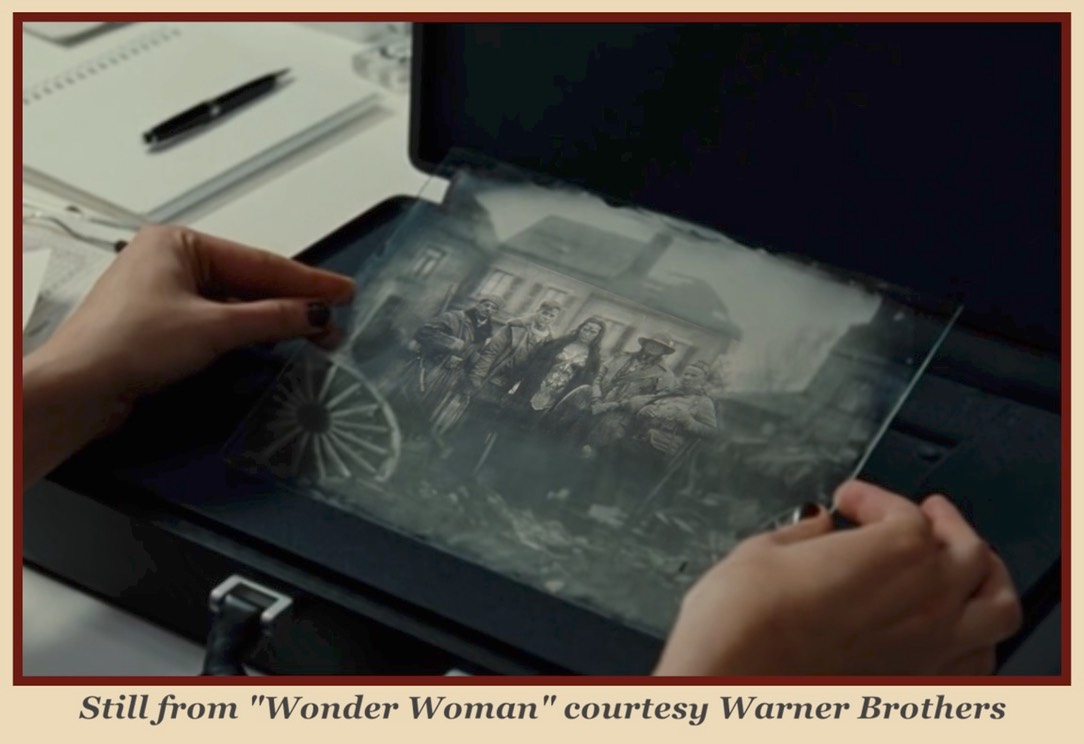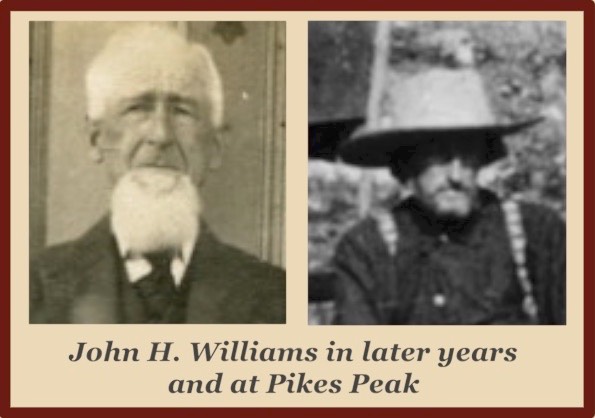Wonder Woman is a rarity in the summer movie-going season, a whiz-bang comic-book blockbuster that is also a fine film with a good heart. Standing out from the stylish mayhem we’ve seen over and over again in the ads, the movie’s most magical special effect may be the photograph that arrives on Diana Princes’s desk in the Louvre at the beginning of the film. It’s a slightly blurry, low-contrast image captured on a glass plate, and depicts a small band of resolute but battle-weary fighters from the First World War. Later in the film we see a cameraman taking the picture in a quaint Belgian village which lies behind enemy lines until the irregulars, led by Princess Diana of Themyscira, storm no-man’s land and drive German troops from the village.

Collodion wet-plate photography is another classic photographic technique I know only a little bit about, but it immediately struck me that the glass plate which Diana gazes at so fondly, should be a negative image instead of a positive. While there is such a thing as a collodion positive, my understanding is that the main advantage of the whole cumbersome process was that it could produce a large negative on glass, allowing numerous paper copies to be made from it (though only one at a time) in a simple contact printer. However, these filmmakers are wily and know their stuff. Collodion plates could be made to appear positive when held against a dark background, such as the interior of a black attache case.
You’ve probably already guessed what a comic-book movie has to do with Pikes Peak, and why I was boning up on wet-plate photography in the first place. The photograph of what I believe are some thirsty new arrivals being greeted by Daniel Chessman Oakes at Riley’s Gulch near Denver in 1859, was probably taken on a glass plate freshly coated with silver iodide, an innovation which was devised in 1851 and remained popular for another 20 years before evolving into something more convenient. It was not for the timid.
Frontier photographers couldn’t just pack up a batch of ready-made photographic plates and cart them into the wilderness. Each one had to be coated with chemicals in a portable darkroom a few minutes before being exposed inside the camera, then hustled back into the darkroom to be developed. Once he started coating the plate, the photographic chemist had only about fifteen minutes to load it into the camera, take the picture and splash it with more chemicals to produce an image, before the plate had a chance to dry.
Just as we see in the movie currently in theaters, as well as in countless old Westerns on television, the camera had no shutter. The photographer simply whisked off the lens cap, counted to five or so, depending on how brightly the sun was shining, replaced the cap, then slid a thin black metal plate over the sensitive glass to shield it from light, before slipping it out of the back of the camera and rushing it to the darkroom.

Something could go terribly wrong at every stage of the process, and there were at least two misfires in the Pikes Peak photo. Everyone stood stock-still during the long exposure - except for the stock. A mule being held by the assistant wagon master standing at the right edge of the frame, decided to express its impatience by kicking up its hind legs at exactly the wrong moment.
Next, a chemical mishap spoiled the plate, marring the image of the key figure of the group, Daniel Chessman Oakes. An expert on the process might come up with a better guess, but a portion of the emulsion could have dissolved when the chemist started to apply a coat of shellac to protect the image, or afterward, when he tried to dry the shellac over a kerosene flame. In any case, the photographic plate was ruined, although at least one print was made from it and handed to John Henry Williams, whose grandson Oscar would donate it to the Denver Public Library.
Oddly enough, the Williams family’s narrative of the life of their ancestor includes no information about a visit to Pikes Peak in 1859, knowing only that he came to Colorado from Michigan with his son Richard in 1868 before moving on, eventually settling in San Jose. Until recently, the standard version of the life of Thomas Lovewell didn’t put him at Pikes Peak in 1859 either. Yet, there both men are, guests of the region’s best-known promoter, posing for an intrepid but apparently klutzy photographer. I’ve guessed before that the cameraman may have been an itinerant amateur named Chamberlain who eventually set up shop in Central City, which is where John H. Williams’ son Richard later became a legendary lawman. However, the October 18, 1860 edition of the Rocky Mountain News carried a small item which suggests that a couple of local boys could have been employed to do the job.
R. E. Cable and Oliver Case, who have been amongst us for some time engaged in the ambrotype and photograph business, leave Denver this afternoon. They expect to spend the winter among the fair senoritas of New Mexico. We hope they have a pleasant time.
Another ambrotype gallery, one that specialized in producing photographic images on leather for mailing to distant relatives, had opened the previous autumn. Only about 15 years after being introduced to North America, photography had firmly taken root along the frontier.
We can make a fairly close estimate of when the picture was taken because of a couple of interesting clues which have only recently come to light. Thomas Lovewell couldn’t have gotten an early start that year because his contract to haul mail between Vermillion City and Nottingham in Territorial Kansas did not expire until May 1859, after which he still had to install his family on a farm in southern Iowa before heading off to St. Joe to stock up on mining equipment and supplies.
At St. Joe he probably ran into John Henry Williams, a miner from Michigan travelling with his father and his brother, both named Collin, recently arrived from Cornwall. Their trip to Denver would have taken about three weeks by ox-drawn wagon. The picture could not have been taken before August, because D. C. Oakes can be seen wearing a black arm band in honor of his favorite little daughter who had died weeks earlier, although Oakes did not receive the news until August 1st. Oakes made at least three trips that year back and forth between Denver and Pacific City, Iowa, heading east one last time in September and returning to Denver Nov. 12. The men could have posed for the photograph any day in August or after mid-November.
There is something magical about holding a frozen moment of time in your hands - particularly one you never expected to find. It was almost as surprising to discover an image of Thomas Lovewell hiding in plain sight in an iconic Western photo as it would be to, say, spot a 21st century superhero in a group portrait taken in the First World War. The photographic plate in Wonder Woman works on the audience much the way that the real-life Pikes Peak photo did on me. When we first see it we’re curious to know who all these people might be, where they’re standing, and why the picture had been taken. Seeing it again at the end we’re reminded wistfully of what they did, and what was gained and lost in the experience all of them shared.